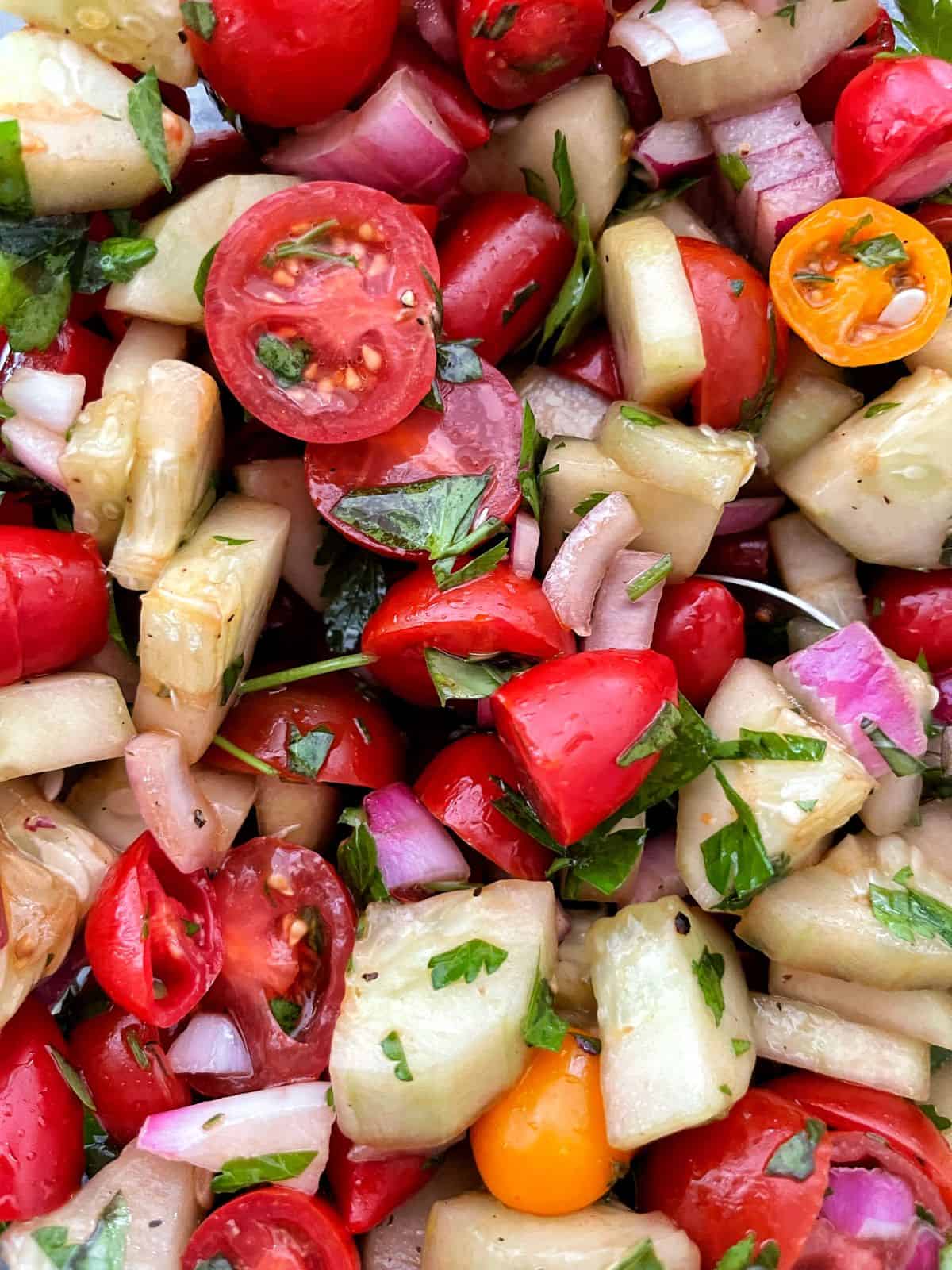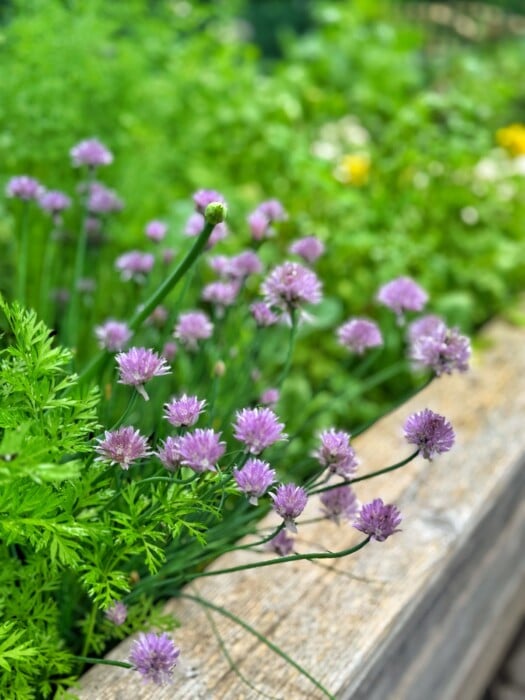Enjoy fresh garden tomatoes all year long! Learn the simple, no-canning method for freezing tomatoes in this easy guide.
My garden is overflowing with tomatoes this year! Seriously, it’s a tomato explosion! And while I love a good BLT, there’s no way we can eat them all fresh. So, I’m turning to my freezer to capture that summer goodness and enjoy it all year round.
Freezing tomatoes is surprisingly simple to do. It’s the easiest way to preserve tomatoes and I can’t wait to share the how-to with you!
Don’t have a garden? No problem! Grab some gorgeous tomatoes from your local farmers market and freeze them for later. Trust me, you’ll thank yourself this winter!
(Posts on stacyling.com may contain affiliate links. Click HERE for full disclosure.)

Preserving Your Bountiful Harvest
As every avid gardener knows, the joy of reaping a bountiful tomato harvest is matched only by the challenge of finding ways to use them all before they start to go bad.
Year after year, we find ourselves faced with the amazing predicament of having more tomatoes than we can possibly eat. But fear not!
Freezing tomatoes is a fantastic solution that allows us to savor the flavors of summer even in the depths of winter. In today’s post, we’ll explore how to freeze tomatoes without the need to can them so you can enjoy the bounty of your gardens all year round.

Why Freeze Tomatoes?
Freezing tomatoes is a simple and efficient way to preserve their freshness and flavor. The process locks in their taste and nutritional value, allowing you to harness the essence of summer even when the cold winds are blowing. Here’s why freezing is a great option:
- Preservation of Nutrients: Freezing is one of the best methods for preserving the vitamins, minerals, and antioxidants present in tomatoes.
- Versatility in Cooking: Frozen tomatoes can be used in a wide range of dishes, from soups and sauces to stews and casseroles. They add a burst of flavor and a dash of summer to your winter meals.
- Reduced Food Waste: Instead of watching your hard-earned harvest go to waste, freezing tomatoes ensures that not a single one is lost.

How to Freeze Tomatoes: The Lazy Gardener’s Guide to Avoid Canning
This year, I grew several varieties of tomatoes. From romas and cherries to beefsteaks and patio tomatoes, the harvest was huge this year. And they are all ready to be harvested but not enough people in my family to eat them all.
I would love to spend a day canning them but don’t have the time to dedicate it this year. So freezing them is the next best thing!
It is ridiculously easy to do and the best part? You’ll be able to enjoy fresh tomatoes from your garden any time of year!
Here’s how to do it!

Supplies Needed
Minimal supplies are needed to freeze tomatoes. And you probably have most of it on hand already in your kitchen and vegetable garden.
- stockpot
- sharp knife
- cutting board
- storage containers
- slotted spoon
- ripe tomatoes
Instructions
- Select fresh ripe tomatoes. Wash and dry them.
- Bring a stockpot of water to a boil.
- Cut out the stem tops. And if there is a bottom, cut that off too.
- Carefully drop the tomatoes in boiling water with a slotted spoon. BUT DO NOT COOK! Keep the tomatoes in for about 30-60 seconds tops.
- Remove from boiling water with a slotted spoon and allow tomatoes to cool.
- Peel the skin off and rough chop the tomatoes.
- Place in a freezer-friendly storage container. If needed, add some of the tomato juices so there isn’t a lot of air in the container. This will help prevent freezer burn. Leave about an inch or so to the top of the container to allow for expansion. Do not overfill.
- Label the container with the date and variety and freeze until you are ready to use them.





How to Thaw
To use tomatoes that were frozen, simply remove them from the freezer and allow them to thaw. And then immediately use them in a recipe of your choosing.
Can I refreeze thawed tomatoes?
It’s recommended not to refreeze thawed tomatoes, as this can further affect their overall quality. So it’s best to use the thawed tomatoes in your recipes as intended. Do not refreeze them.
How to Use Frozen Tomatoes
Frozen tomatoes are best used in sauces, salsas, soups, and stews as they can get a little mushy after thawing. But they can be used in countless recipes.
- Tomato Sauces: Thawed tomatoes can be blended into flavorful pasta sauces, pizza sauces, or even homemade ketchup.
- Soups and Stews: Add frozen tomatoes directly to soups, stews, and chili for a rich and vibrant base.
- Curries and Casseroles: Elevate the taste of curries and casseroles with the bright tanginess of frozen tomatoes.
- Salsas and Dips: Whip up delightful salsas, dips, and spreads using thawed tomatoes for a burst of freshness.
The flavor is still there, but the consistency is a bit softer than prior to freezing them which is why it is best if used in recipes like the above.
Thawing and Storage
To use your frozen tomatoes, simply transfer the desired amount from the freezer to the refrigerator. Let them thaw slowly, allowing the flavor and texture to be retained. Once thawed, they might release some liquid, so be sure to account for this in your recipes.
Preserved tomatoes can be stored in the freezer for about 8 to 12 months. While they will remain safe to eat beyond this timeframe, the quality might diminish over time.

Preserving Tomatoes FAQs
What Is the Best Way to Freeze Fresh Tomatoes?
While you can freeze tomatoes whole, they actually work better if you cut them in half. There are a few ways to do it.
- Blanch and place in an airtight, food-safe container for freezing.
- Slice tomatoes in half, put on a baking sheet, pop in the freezer for 2 hours then place in freezer-safe bags for long-term freezing.
- Slice tomatoes in half, place in a rigid freezer-safe container, and flash freeze.
Since I typically use my frozen tomatoes for Sunday sauce, salsa for loaded nachos, bruschetta, and creamy balsamic tomato soup, I prefer blanching them. The consistency is easier to work with after freezing and tastes SO FRESH in dishes during the off-season.
True, the blanching process is a bit more laborious than the other two methods, but to me, it creates a better consistency for use later.
Is It Best to Blanch Tomatoes Before Freezing?
To me, blanching is a personal preference. I suggest you try the various methods of freezing tomatoes and see which one you prefer.

Is it Better to Freeze Tomatoes Whole or Chopped?
Both freezing whole tomatoes and freezing chopped tomatoes have their benefits, and the choice ultimately depends on how you plan to use them in the future. Here are the advantages of each method:
Freezing Whole Tomatoes
Advantages:
- Easier Prep: Freezing whole tomatoes requires minimal preparation. You only need to wash and core them before freezing.
- Versatile: Whole frozen tomatoes can be used in a variety of dishes. They are great for soups, stews, sauces, and can even be roasted or grilled once thawed.
- Retain Texture: Freezing whole tomatoes helps maintain their natural shape and texture. They may be more suitable if you prefer firmer tomatoes in your recipes.
Considerations:
- Thawing Time: Whole tomatoes may take longer to thaw compared to chopped tomatoes, especially if they are larger in size.
- Peeling: If you plan to use the tomatoes for recipes that require peeled tomatoes, you’ll need to remove the skin after thawing.

Freezing Chopped Tomatoes
Advantages:
- Faster Thawing: Chopped tomatoes have more surface area exposed to air, so they generally thaw faster than whole tomatoes.
- Pre-Portioned: By chopping the tomatoes before freezing, you can portion them into smaller quantities. This makes it easier to take out only the amount you need for your recipes.
- Convenient for Certain Dishes: Chopped tomatoes are particularly convenient for recipes that call for diced or crushed tomatoes, such as sauces, salsas, and pasta dishes.
Considerations:
- Texture Changes: Chopped tomatoes may become softer after freezing and thawing, which could be beneficial in recipes where a saucy consistency is desired but might not work as well in dishes where you want distinct tomato pieces.

The Bottom Line
Both whole and chopped tomatoes can be successfully frozen and used in various dishes. If you want versatility and minimal prep, freezing whole tomatoes might be the way to go.
On the other hand, if you prefer faster thawing and easy portioning, chopping the tomatoes before freezing could be more convenient. Consider how you plan to use the tomatoes in your recipes and choose the method that aligns best with your cooking style and preferences.
Ultimately, whether they are whole or chopped, frozen tomatoes are a fantastic way to savor the flavors of summer all year round.


Final Thoughts About Preserving Tomatoes
And there you have it! Freezing tomatoes is truly a game-changer. It’s my little secret weapon for infusing those cold winter months with the bright, juicy flavors of summer. Trust me, once you pull out a bag of your own frozen tomatoes in January, you’ll never go back to those bland, store-bought ones again.
It takes about an hour or so from start to finish. But it is totally worth it to enjoy fresh tomatoes from the garden year-round.
Happy freezing, and happy eating! Let me know in the comments if you give this a try – I’d love to hear how it goes.
For more information about preserving your tomato harvest, read this article from the University of Minnesota Extension.
Thank you so much for following along.
Enjoy a beautiful day! xo





My Favorite Fresh Tomatoes Recipes
One of the best parts about growing tomatoes is harvesting and using them in the kitchen.
Wait until you try some of my favorite tomato-based recipes!
- Bruschetta Tomatoes Recipe from Grandma’s Vault
- Simple Salad with Cucumbers, Tomatoes and Onion
- The Best Recipe for Caprese Salad
- Loaded Nachos
- Quick and Easy Spinach Tortellini Soup
- How to Make Sunday Sauce with Meatballs Like a Pro









